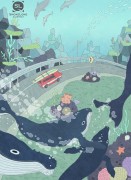Where did the idea for these characters come from?
One summer when I was in eighth or ninth grade, a girl from my dance studio went to dance camp and I remember feeling so jealous of her. We weren’t friends outside of the studio—she went to a different school and was a couple years older than me—but I asked her to write to me that summer and she did, which was such an act of kindness. I think I still have those letters somewhere.
I’ve always loved dance and wrote a lot of ballet stories when I was young. With this story, I set out to write a dance camp story. But since this story spends more time in Shelly’s apartment and the grocery store than it does at dance camp, I failed in that regard. I had the first line in my head for a while and knew I wanted to explore how a friendship would change after one friend went away for a summer. The story went in a much different direction than I intended but that initial premise is still there.
You often write—and write really well—about young women in adolescence or early adulthood, and the subtle cruelties these women can inflict upon one another. What draws you to these themes?
I think a lot of people basically spend their adult lives trying to recover from their adolescence. My grandmother once told me that high school was the best time of her life. I was completely mystified by that statement. High school was where I first learned how cruel women can be, including myself. It’s a confusing time—one day someone is your friend and the next day they aren’t, one day you’re in love with a guy and the next day you’re not—everything is constantly changing. I think it’s easy for me to tap into the situations and emotions of adolescence, probably because I’m still recovering from it.
I know you had some trouble naming the baby in this story. I get very wedded to a name once I commit to it and I have trouble changing it in a story. What is your normal process for naming characters? Do you just pick whatever comes into your head first and go with it? Decide beforehand in a deliberate way? Switch them out after it’s been written?
That baby has been nothing but trouble! I’ll frequently change names when I’m drafting and revising. I keep a list of names in a notebook and I’ll sometimes refer to that. Other times I look around my office and pick a name from a book spine to use as a placeholder.
For the baby, I wanted to make sure I picked a name that Shelly would have picked. Because the name choice revealed character, I was careful with the choice. As I was revising, I realized the first name I selected wasn’t right because Shelly would have picked a popular name for that time period (but not one of the most popular). I looked at baby name lists online for the year the story takes place and then I went back a couple years because I didn’t think Shelly would have a pulse on current baby name trends.
Now that you’re 3/4 through your fellowship at SmokeLong, how have you seen your writing change and evolve?
I’m pushing myself more—to go deeper (maybe stick with an image longer or try to turn it on its head), to get a little weirder, and to really stick the endings.
Is there any kind/type of story that you wish you could write but that you haven’t attempted yet?
I’d love to write a fairytale retelling or a story with magical elements. Both of those feel outside my comfort zone.




 The core workshop of SmokeLong Fitness is all in writing, so you can take part from anywhere at anytime. We are excited about creating a supportive, consistent and structured environment for flash writers to work on their craft in a community. We are thrilled and proud to say that our workshop participants have won, placed, or been listed in every major flash competition. Community works.
The core workshop of SmokeLong Fitness is all in writing, so you can take part from anywhere at anytime. We are excited about creating a supportive, consistent and structured environment for flash writers to work on their craft in a community. We are thrilled and proud to say that our workshop participants have won, placed, or been listed in every major flash competition. Community works.